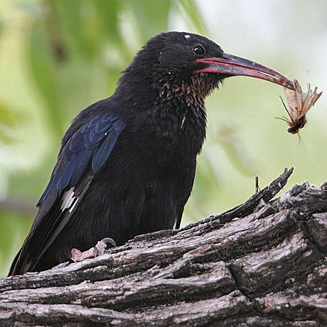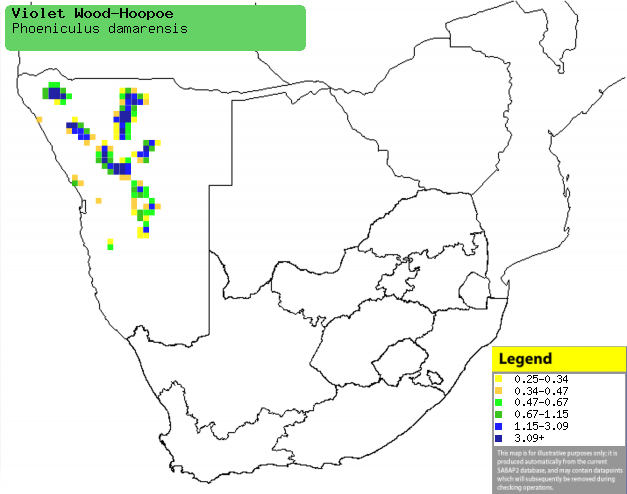|
Phoeniculus damarensis (Violet
wood-hoopoe)
Perskakelaar [Afrikaans]; Damara-kakelaar [Dutch]; Irrisor
damara [French]; Damarabaumhopf [German]; Zombeteiro da Damaralāndia
[Portuguese]
Life
> Eukaryotes >
Opisthokonta
> Metazoa (animals) >
Bilateria >
Deuterostomia > Chordata >
Craniata > Vertebrata (vertebrates) > Gnathostomata (jawed
vertebrates) > Teleostomi (teleost fish) > Osteichthyes (bony fish) > Class:
Sarcopterygii (lobe-finned
fish) > Stegocephalia (terrestrial
vertebrates) > Tetrapoda
(four-legged vertebrates) > Reptiliomorpha > Amniota >
Reptilia (reptiles) >
Romeriida > Diapsida > Archosauromorpha > Archosauria >
Dinosauria
(dinosaurs) > Saurischia > Theropoda (bipedal predatory dinosaurs) >
Coelurosauria > Maniraptora > Aves
(birds) > Order: Upupiformes >
Family: Phoeniculidae
 |
|
|
Violet wood-hoopoe with caught insect, Etosha
National Park, Namibia. [photo Trevor Hardaker ©] |
|
The Violet wood-hoopoe's population is small and localized,
with an estimated 1 650 birds scattered across Namibian and Angolan Mopane
woodland. It is mostly insectivorous, foraging in trees, occasionally dropping
to the ground to pick up an insect. It is a monogamous, cooperative breeder,
meaning that non-breeding birds help the breeding pair with incubation and
caring of the chicks. It nests in tree cavities, laying 4-5 eggs, which are
incubated solely by the female. The chicks are cared for by the female, who is
supplied with food hunted by the male or group members
Distribution and habitat
Its population is small and localized,
with an estimated 1 650 birds scattered across Namibia and extending into southern
Angola (not included in population figure). It generally prefers Mopane (Colosphermum
mopane) woodland, but it may also move into other types of arid woodland.
|
 |
|
Distribution of Violet wood-hoopoe in southern Africa,
based on statistical smoothing of the records from first SA Bird Atlas
Project (©
Animal Demography unit, University of
Cape Town; smoothing by Birgit Erni and Francesca Little). Colours range
from dark blue (most common) through to yellow (least common). |
Call
Food
Mostly insectivorous, doing most of its foraging in
trees, occasionally dropping to the ground to pick up an insect. The following
food items have been recorded in its diet:
Breeding
- It is a monogamous, cooperative breeder, meaning that
non-breeding birds help the breeding pair with incubation and caring of the
chicks.
- It usually nests in tree cavities, either natural or made by a barbet or
woodpecker.
- Egg-laying season is from December-April.
- It lays 4-5 eggs, which are incubated solely by the female, who is fed
by the male and the other group members.
- The chicks are cared for solely by the female, while the rest of the
group (including the male) provide food for her and the chicks.
Threats
Due its small and localized population it is considered to
be at risk, although this has not officially been recognised.
References
-
Hockey PAR, Dean WRJ and Ryan PG (eds) 2005. Roberts
- Birds of southern Africa, VIIth ed. The Trustees of the John Voelcker
Bird Book Fund, Cape Town.
|
